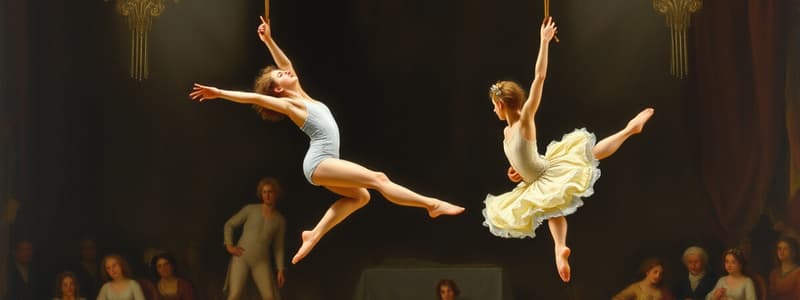Podcast
Questions and Answers
What is the primary focus of the Still Rings event in gymnastics?
What is the primary focus of the Still Rings event in gymnastics?
- Demonstrating endurance and strength with holds. (correct)
- Propelling over a vaulting table at speed.
- Showing circles and flairs above the horse.
- Performing complex tumbling sequences.
Which gymnastics event is described as the fastest and involves sprinting?
Which gymnastics event is described as the fastest and involves sprinting?
- Vault (correct)
- Pommel Horse
- Parallel Bars
- Floor Exercise
What element is NOT typically associated with the Pommel Horse event?
What element is NOT typically associated with the Pommel Horse event?
- Swinging elements
- Performing flairs
- Tumbling sequences (correct)
- Displaying circles
Which two gymnastics events are considered power events?
Which two gymnastics events are considered power events?
What common feature do Parallel Bars and Horizontal Bar share?
What common feature do Parallel Bars and Horizontal Bar share?
Why is it important for goals to be set jointly by the coach and athlete?
Why is it important for goals to be set jointly by the coach and athlete?
What is a primary characteristic of long-term goals in athlete training?
What is a primary characteristic of long-term goals in athlete training?
Instead of focusing solely on competition outcomes, what should athletes focus on during training?
Instead of focusing solely on competition outcomes, what should athletes focus on during training?
How should goals be structured for effective training progression?
How should goals be structured for effective training progression?
What role do measurable goals play in an athlete's training?
What role do measurable goals play in an athlete's training?
Why should goals vary in difficulty for athletes?
Why should goals vary in difficulty for athletes?
Which factor should NOT be considered when setting an athlete's goals?
Which factor should NOT be considered when setting an athlete's goals?
What is an effective way to view goals in an athlete's training plan?
What is an effective way to view goals in an athlete's training plan?
Flashcards are hidden until you start studying
Study Notes
Floor Exercise
- Features tumbling and acrobatic routines on a specialized mat designed for safety.
- Encourages creativity and artistry along with technical skill.
Pommel Horse
- Requires gymnasts to perform circular movements and flairs above the apparatus.
- Emphasizes upper body strength and balance while maintaining fluid movements.
Still Rings
- Focuses on endurance and strength as gymnasts support their body weight.
- Involves complex holds that challenge both muscular control and stability.
Vault
- Considered one of the two power events alongside Floor Exercise.
- Fast-paced event where gymnasts sprint before launching off a vaulting table, showcasing explosive power.
Parallel Bars and Horizontal Bar
- Both are swinging events characterized by dynamic movements and skillful uses of momentum.
- Involves frequent release transitions, requiring precise timing and coordination for safe landings.
Coaching and Goal Setting for Athletes
- Coaches assess athletes’ progress in development and improvement through structured goal setting.
- A progressive training approach is facilitated by clearly defined goals, allowing adjustments based on athlete progress.
- Efficient management of training sessions is achieved by establishing clear objectives and expectations.
- Goal setting promotes organization and time management skills for both coaches and athletes.
- Clear expectations help athletes focus on personal achievements rather than solely on competition outcomes.
Collaborative Goal Setting
- Goals should be established together by both coach and athlete to ensure alignment and confidence.
- Athletes may perceive realistic goals differently; what seems attainable to a coach may appear daunting to an athlete due to self-doubt.
Types of Goals
- Goals should be categorized as short-term, intermediate, and long-term:
- Short-term goals focus on mastering body and apparatus skills.
- Intermediate goals involve sequencing apparatus skills with body movements.
- Long-term goals are aimed at perfecting routines and participating in competitions.
Goals as Steppingstones
- Each goal serves as a steppingstone to success; complex skills should be broken down into manageable parts.
- Athletes should receive praise for achieving individual components of complex skills to build confidence.
Variation in Goal Difficulty
- Goals need to vary from easily achievable to more challenging to create a sense of success in every training session and competition.
Measurable Goals
- Goals must be tangible and measurable, allowing athletes to recognize when they have achieved them.
Training and Competition Plans
- Goals should inform the athlete's overall training and competition strategy, catering to both short-term and long-term aspirations.
- Motivation can be boosted by short-term goals, especially for athletes with intellectual disabilities, while still challenging all athletes to stretch their abilities.
Factors Influencing Motivation and Goal Setting
- Participation factors that can affect goal setting motivation include:
- Age appropriateness
- Ability level
- Readiness level
- Performance history
- Family and peer influence
- Athlete preferences
Studying That Suits You
Use AI to generate personalized quizzes and flashcards to suit your learning preferences.




